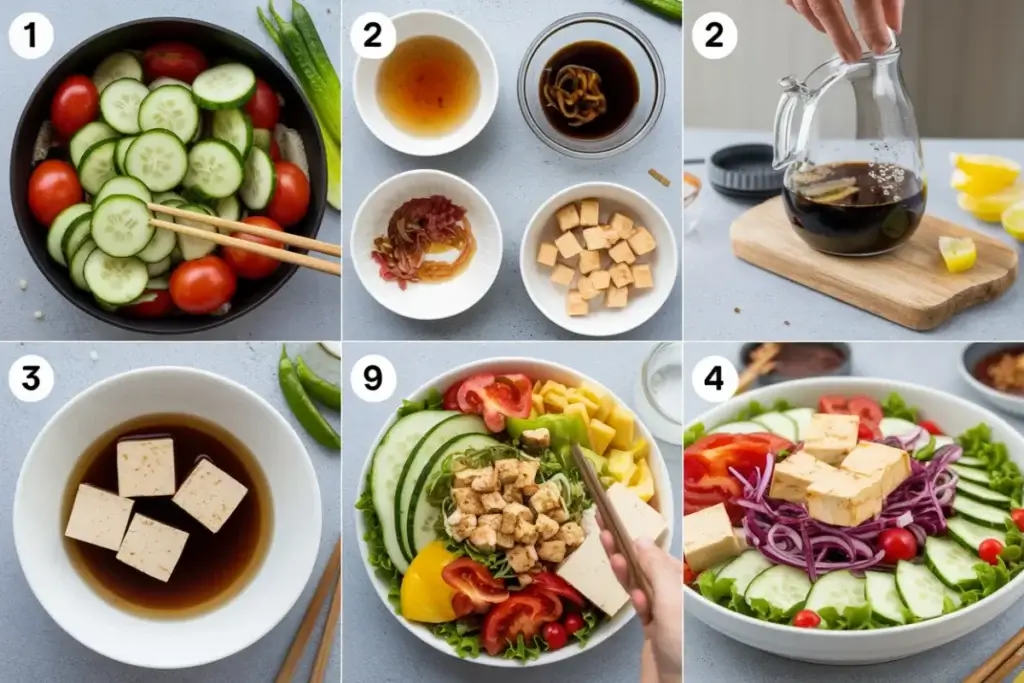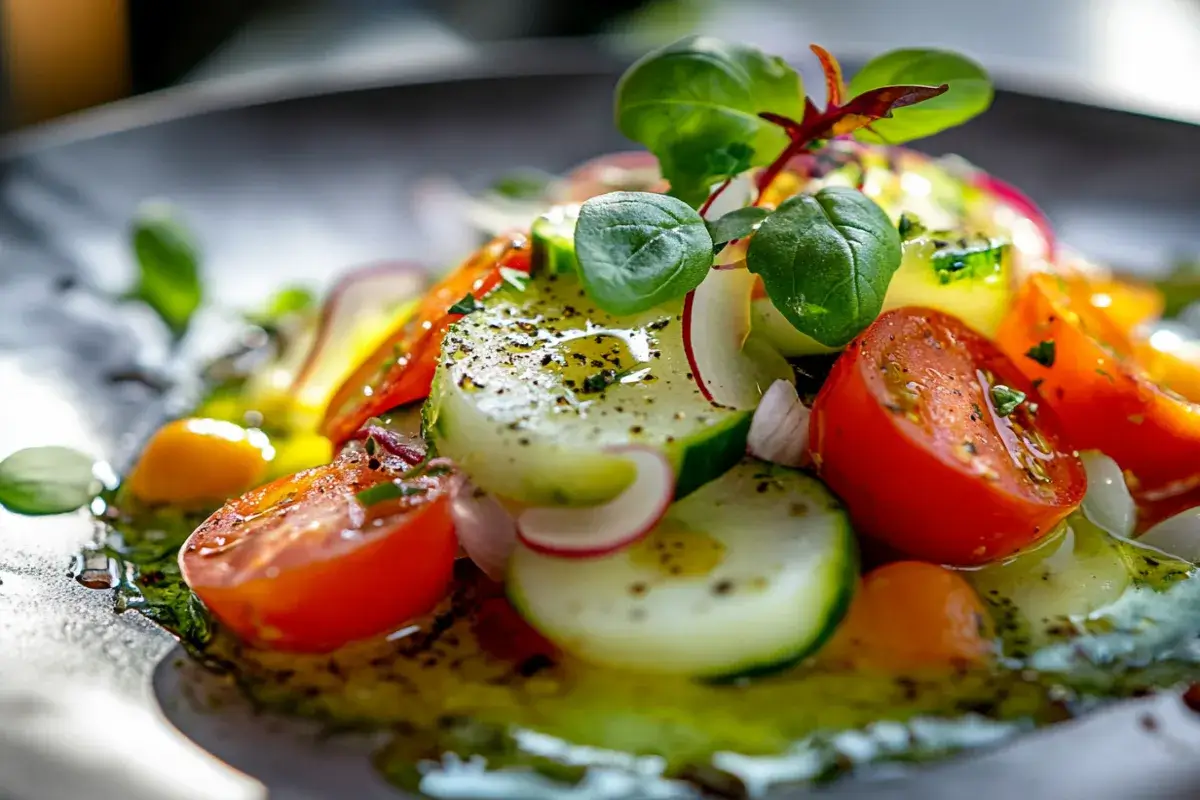Part 1: Introduction
If you’ve ever been to a potluck or family gathering, you might have encountered the intriguingly named frog eye salad. Don’t worry—it has nothing to do with actual frogs! This sweet and creamy dish is a classic, especially in the western United States, and has been winning hearts (and taste buds) for decades. The name comes from the tiny pasta pearls that resemble frog’s eyes, making this dish as fun as it is delicious. In this guide, we’ll dive into everything you need to know about frog eye salad, from its origins to the best ways to make it.
Part 2: What is Frog Eye Salad?
Definition and Origin
Frog eye salad is a unique dish that combines pasta with fruit and a creamy dressing, resulting in a delightful mix of textures and flavors. The main component is acini di pepe pasta—tiny, round pasta pieces that resemble small pearls or, as the name suggests, frog’s eyes. This pasta is mixed with a variety of fruits such as pineapple and mandarin oranges, and a creamy dressing that typically includes eggs, sugar, and whipped topping.
The origins of frog eye salad are somewhat murky, but it’s believed to have become popular in the mid-20th century, especially in the western U.S. It’s a staple at family gatherings, potlucks, and holiday dinners, offering a nostalgic taste that many people grew up with. Its sweet, tangy flavor combined with the chewy texture of the pasta and the lightness of the whipped topping makes it a crowd-pleaser for both kids and adults alike.
For more context on pasta dishes, check out this Wikipedia article on Pasta.
Part 3: Ingredients Overview
Main Ingredients
To make the perfect frog eye salad, you’ll need a combination of basic pantry items and some canned fruit. Here’s a breakdown of the main ingredients:
- Acini di pepe pasta: This is the star of the show, giving the salad its distinctive “frog eye” appearance.
- Crushed pineapple and pineapple tidbits: These add sweetness and a bit of tang to the salad.
- Mandarin oranges: The juicy segments provide a burst of citrus flavor.
- Coconut (optional): Shredded coconut adds a tropical flair and extra texture.
- Marshmallows: Mini marshmallows contribute to the salad’s sweetness and give it a soft, pillowy texture.
- Whipped topping or homemade whipped cream: This adds creaminess and lightness to the salad.
- Eggs: Used in some recipes to create a custard base for the dressing.
- Vanilla pudding mix or homemade vanilla custard: This thickens the dressing and adds flavor.
Special Ingredients
Depending on your preferences, you can also add some special ingredients to customize your frog eye salad:
- Maraschino cherries: These add color and a burst of sweetness.
- Bananas: Sliced bananas can be mixed in for extra fruitiness.
- Nuts: Chopped walnuts or pecans can add a bit of crunch to the salad.
Part 4: Step-by-Step Recipe Guide

Preparation of the Acini di Pepe Pasta
The first step in making frog eye salad is preparing the acini di pepe pasta. This small, round pasta cooks quickly, so it’s important to keep an eye on it to avoid overcooking.
- Boil water: Bring a large pot of water to a rolling boil. Add a pinch of salt to enhance the flavor of the pasta.
- Cook the pasta: Add the acini di pepe pasta to the boiling water. Cook for 8-10 minutes, or until the pasta is al dente.
- Drain and rinse: Once the pasta is cooked, drain it in a colander and rinse with cold water to stop the cooking process and cool the pasta down. This also helps prevent the pasta from sticking together.
- Set aside: Let the pasta drain thoroughly and set it aside while you prepare the rest of the ingredients.
Making the Dressing
The dressing is what brings all the ingredients of the frog eye salad together. It’s creamy, sweet, and perfectly complements the fruit and pasta.
- Prepare the custard (if using eggs): In a saucepan, whisk together sugar, flour, and a pinch of salt. Gradually add in pineapple juice and beaten eggs. Cook over medium heat, stirring constantly until the mixture thickens and bubbles. Remove from heat and stir in lemon juice for a bit of tang. Let it cool completely before using. If you’re interested in mastering the art of cooking eggs, check out our guide on Perfect Over Medium Eggs.
- Mix the pudding (if using vanilla pudding mix): If you prefer a simpler method, combine vanilla pudding mix with milk and beat until smooth. This option skips the egg step and is quicker.
- Combine with whipped topping: Gently fold the prepared custard or pudding mixture into the whipped topping. This will create a light, fluffy dressing that isn’t too heavy.
Combining the Ingredients
Now that your pasta is ready and the dressing is made, it’s time to bring everything together.
- Mix the pasta and fruit: In a large mixing bowl, combine the cooked acini di pepe pasta with the drained pineapple tidbits, crushed pineapple, and mandarin oranges. If you’re adding cherries or bananas, fold them in at this stage.
- Add the dressing: Pour the creamy dressing over the pasta and fruit mixture. Gently fold everything together until the fruit and pasta are evenly coated with the dressing. Be careful not to overmix, as this could break down the fruit.
- Incorporate marshmallows and coconut: Finally, fold in the mini marshmallows and shredded coconut (if using). These add texture and sweetness, making the salad even more irresistible.
Chilling and Serving
Once your frog eye salad is assembled, it’s important to let it chill for a few hours before serving. This allows the flavors to meld together and gives the salad a refreshing, cold texture.
- Cover and chill: Cover the salad bowl with plastic wrap and refrigerate for at least 2-3 hours. This step is crucial for the salad to firm up and the flavors to blend.
- Serve: When you’re ready to serve, give the salad a quick stir and transfer it to a serving dish. Garnish with additional fruit or a sprinkle of coconut for a decorative touch.
Part 5: Variations and Customizations
Traditional vs. Modern Variations
The classic frog eye salad recipe is beloved by many, but there are plenty of ways to tweak it to suit your tastes.
- Traditional Version: The traditional recipe typically includes acini di pepe pasta, a custard-based dressing, and fruits like pineapple and mandarin oranges.
- Modern Version: For a quicker version, many people use instant vanilla pudding instead of making the custard from scratch. This version is easier and still delicious.
Regional Variations
Frog eye salad is especially popular in the western U.S., but different regions have put their own spin on the dish.
- Southwest: In some southwestern states, you might find versions with added spices or citrus zest for a little extra kick.
- Midwest: The Midwest often sticks to the classic recipe but sometimes adds unique fruits like grapes or apples.
Part 6: Nutritional Information
Nutritional Breakdown
While frog eye salad is delicious, it’s also important to consider its nutritional content. Here’s a rough breakdown for a typical serving:
- Calories: Around 250-300 calories per serving, depending on the ingredients used.
- Fat: The salad can be high in fat due to the whipped topping and eggs. To reduce fat content, consider using a lighter whipped topping or substituting Greek yogurt.
- Sugar: This dish is also high in sugar due to the fruits, marshmallows, and dressing. Reducing the sugar in the dressing or using sugar-free pudding mix can help lower the sugar content.
Part 7: Frog Eye Salad for Different Occasions
Seasonal Adaptations
Frog eye salad can be easily adapted for different seasons and holidays.
- Spring/Easter: Add pastel-colored marshmallows or top with fresh strawberries for a festive touch.
- Summer/4th of July: Incorporate red, white, and blue fruits like strawberries, blueberries, and bananas to match the holiday theme.
- Fall/Thanksgiving: Mix in dried cranberries or add a sprinkle of cinnamon to give it a warm, autumnal flavor. Pair your autumn-inspired frog eye salad with a slice of Pumpkin Pie Cake for a festive treat.
Serving Suggestions
Frog eye salad is versatile and can be served in various ways:
- As a side dish: It’s often served alongside grilled meats or barbecue at summer cookouts.
- As a dessert: This salad is sweet enough to be enjoyed as a dessert, especially after a heavy meal.
Part 8: Common Mistakes to Avoid
Troubleshooting Guide
Even with a straightforward recipe like frog eye salad, things can go wrong. Here’s how to avoid common pitfalls:
- Overcooking the pasta: If the acini di pepe pasta is overcooked, it can turn mushy and ruin the texture of the salad. Make sure to cook it just until al dente.
- Not cooling the custard: If you don’t let the custard cool completely before mixing it with the whipped topping, it can cause the salad to become too runny.
- Overmixing: Be gentle when folding the ingredients together. Overmixing can break down the fruit and create a mushy salad.
Part 9: Frequently Asked Questions (FAQs)
FAQs Section
- Why is it called frog eye salad? The name comes from the acini di pepe pasta, which resembles tiny frog’s eyes when cooked. It’s a quirky name that adds to the dish’s charm.
- Can I make frog eye salad ahead of time? Yes! In fact, making it a day ahead allows the flavors to meld together even better. Just make sure to store it in the fridge.
- How do I store leftovers? Leftovers can be stored in an airtight container in the refrigerator for up to 3 days. Give it a quick stir before serving again.
- Can I use different types of pasta? While acini di pepe is traditional, you can experiment with other small pasta shapes like orzo or couscous. However, this may alter the texture.
- Is there a substitute for the whipped topping? You can use homemade whipped cream or even Greek yogurt for a tangier, lighter version of the salad.
Part 10: Conclusion
Wrapping Up
Frog eye salad is more than just a quirky name—it’s a delightful, nostalgic dish that has stood the test of time. With its sweet, creamy dressing, juicy fruit, and chewy pasta, it’s no wonder this salad is a staple at gatherings across the country. Whether you stick to the traditional recipe or put your own spin on it, frog eye salad is sure to be a hit at your next potluck. So go ahead, give it a try, and bring a bit of retro charm to your table!
For more information on pasta dishes, visit Wikipedia. And if you’re curious about the history of desserts, you might enjoy this Wikipedia article on the History of Desserts.

